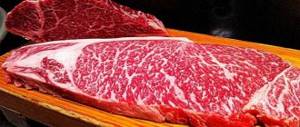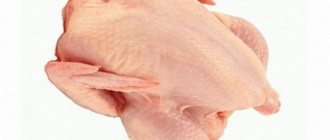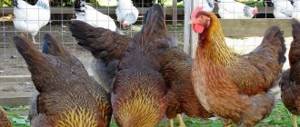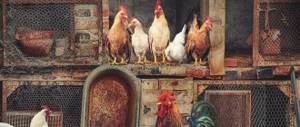The guinea fowl is an African bird that found its way to Europe back in antiquity. Its meat, which tastes like game meat, immediately won its place on the tables of European gourmets. It contains less fat than chicken, and in terms of protein, amino acids, vitamins and microelements it significantly exceeds any other poultry, so it can be included in the diet of children, the sick, pregnant women and the elderly.
Types of meat
Guinea fowl are the closest relatives of quails, turkeys and chickens, which belong to the Guinea fowl family. They were brought to Europe from the southern and western regions of Africa. Guinea fowl, and therefore its meat, can be:
- Wild . As a rule, it lives in Africa, in its historical homeland. Wild birds are often hunted.
- Homemade or ordinary . It is bred in Europe and the CIS countries on modern farms. It is the meat of such poultry that can be found in the windows of butcher shops.
There are different breeds of guinea fowl in nature, but breeders are actively breeding several of them - gray-speckled, cream, Volga white, Zagorsk and white-breasted.
Appearance and taste
To distinguish a guinea fowl carcass, you should know what it looks like. Here are the main characteristics:
- Weight . The bird is usually sent for slaughter at the age of 3-5 months, so it weighs little - up to 1.5 kg. Of course, the older the bird, the more plump its carcass looks.
- Peel . The skin of a guinea fowl carcass is very thin, so the red meat shows through, which is why the carcass may appear brown. In addition, the skin is darker than that of chicken, since it contains large quantities of myoglobin, a protein that in its structure and functions resembles hemoglobin.
- Color . The meat has a bluish tint, but you should not be afraid of this, since this color is due to the low amount of fat it contains. Guinea fowl fillet contains a large amount of hemoglobin, so it may have a brown color. After heat treatment, the meat brightens and becomes almost white.
- Bones . Guinea fowl has fewer bones compared to chicken. In addition, they are not so large, which is why the carcass looks quite miniature.
Guinea fowl meat tastes not like chicken, but pheasant or game, since it contains less liquid (only 74.4 g per 100 g) and higher fiber density. In addition, it is not as fatty as chicken meat - per 100 g it contains 2.7 g of fat, while in chicken this figure is 8.8 g.
Features of domestic guinea fowl meat
The average weight of adult guinea fowl is:
- in males - about 1600 g;
- in females (guinea fowl are larger than guinea fowl) - around 1900.
Expert opinion
Novoselova Sofya Ivanovna
Farmer. 20 years of experience.
Ask a Question
Some meat breeds (such as the French broiler, also known as the grey-speckled) can reach a live weight of 2.5 kg or more. Basically, they begin to prepare a bird for slaughter when its weight reaches 1100-1200 g - this is usually 11-12 weeks old. At the same time, young animals that are already one kilogram are considered to have reached slaughter age.
Since live weight includes plumage, intestinal contents and other inedible parts of the carcass, the actual meat yield from a slaughtered guinea fowl is much less. On average, after slaughter the following results are obtained:
- The ratio of meat to live weight is 84-85%. Taking into account that during mass breeding, one-kilogram young animals are usually slaughtered (they have the most tender and tasty meat), you can get up to 850 g of product from one head.
- The weight of the breast, the most valuable part of the meat , is up to 22% of live weight.
Feathers are an added bonus when slaughtering. After slaughter, you can get up to 100 g of feather and down from one bird.
The meat itself can be characterized as follows:
- Unlike chicken, it is less fatty and more fibrous.
- The color of the meat depends on the breed. In white guinea fowl it is pink, the same shade as chicken, and in breeds with dark plumage (that is, less influenced by selection) it is dark red, more like game.
- Often, uncut guinea fowl carcasses have a bluish tint to the meat. There is no need to be afraid of this: this color is associated with less fat than in chicken, and also due to the significant content of the oxygen-binding protein myoglobin in the guinea fowl muscles.
- The meat is denser, so it is recommended to stew or boil guinea fowl breast - it is not suitable for frying.
- Compared to chicken, guinea fowl meat tastes denser and drier, with a characteristic gamey taste (very much like pheasant meat). Nevertheless, it is closest to chicken in terms of taste - it is basically impossible to confuse it with duck or goose.
Have you ever tried guinea fowl meat?
Not really
Storage
When storing guinea fowl meat it requires the following conditions:
- Freshly slaughtered poultry meat can be stored for 1-2 days on the bottom shelf of a household refrigerator at a temperature below +10 degrees. If vacuum packaging is used, storage for up to three days under the same conditions is acceptable. It is strictly forbidden to keep meat at above-zero temperatures for longer.
- In the freezer, a carcass packed in a vacuum bag can be easily stored from 3 months to six months.
- When deep frozen (down to -20 degrees), it is permissible to store the cut carcass in a vacuum bag for up to 1 year. However, this option is undesirable, since during long-term storage the meat loses its taste.
Comparative composition of guinea fowl meat and broiler chicken
Contents per 100 g:
| Indicator name | Unit | Value for guinea fowl meat | Value for chicken meat |
| Iron | Mg | 0,77 | 0,89 |
| Copper | Mkg | 11,6 | 53 |
| Phosphorus | Mg | 169 | 173 |
| Selenium | Mkg | 17,5 | 15,7 |
| Vitamin A | Mkg | 12 | 16 |
| Vitamin B1 | Mkg | 67 | 73 |
| Vitamin B2 | Mkg | 112 | 142 |
| Vitamin B5 | Mg | 0,936 | 1,058 |
| Vitamin B6 | Mg | 0,47 | 0,43 |
| Vitamin B12 | Mkg | 0,37 | 0,37 |
| Vitamin PP | Mg | 8,78 | 8,24 |
It is easy to see that both types of products are similar in minerals. Except that chicken is a significant leader in copper content, but in terms of vitamins, chicken is slightly ahead of guinea fowl.
Broilers are not only dietary meat, but also large eggs. Top 5 and description of popular broilers
Read
Three ways to cut a chicken carcass into pieces. Technology of portioned, waste-free cutting methods
More details
Giants of the chicken world: chicken breeds with officially registered heavyweight roosters
Look
Broilers are meat chickens that are genetically engineered for rapid weight gain.
Further
Nutritional value and chemical composition
Guinea fowl meat is valued for its high protein and low fat content. The nutritional value of the product is presented in the table:
| Name | Quantity per 100 g |
| Squirrels | 20.64 g |
| Fats | 2.47 g |
| Carbohydrates | 0.6 g |
| Water | 74.44 g |
| Ash | 1.15 g |
| Saturated fatty acids | 0.64 g |
| Cholesterol | 0.63 g |
| Calorie content | 110 kcal |
So, a hundred-gram piece of meat contains only 110 kcal. For comparison, it should be noted that the calorie content of chicken meat per 100 g is 170 kcal.
Guinea fowl meat is also valued for its rich chemical composition, which we will consider in more detail.
Vitamins
Guinea fowl meat actually holds the record for the content of water-soluble B vitamins:
- B 1 (thiamine) . Promotes human development and growth, actively participates in metabolic processes.
- B2 (riboflavin) . Takes part in metabolism, helps reduce blood sugar levels and improve skin condition.
- B5 (pantothenic acid) . Participates in the metabolism of carbohydrates and fats, as well as in hormonal processes.
- B6 (pyridoxine) . Participates in the synthesis of substances, supports the nervous system and activates brain activity.
- B9 (folic acid) . Takes part in the synthesis of cells and amino acids. Acid is especially useful for pregnant women.
- B12 (cobalamin) . Affects blood composition, improves skin condition, supports the immune system and nervous system.
In addition to B vitamins, meat is also rich in vitamins A, C and PP, due to which it has the following properties:
- has an antioxidant effect;
- improves the condition of hair and skin;
- lowers cholesterol levels and strengthens blood vessels;
- strengthens the body's protective properties.
Amino acids
Scientists have found that poultry breast contains 95% of the beneficial amino acids that are necessary for the healthy functioning of the human body. For comparison, we note that the breast muscles of a broiler contain less acids - 82%.
The amino acids contained in guinea fowl meat include:
- Valin . Takes part in tissue synthesis and maintains muscle strength, gives the body vital energy and the hormone of joy (serotonin). Valine also serves as protection for the myelin sheath of nerve fibers in the brain and spinal cord. Thanks to this, the amino acid significantly delays the rate of development of multiple sclerosis.
- Histidine . This is an essential substance that promotes cell regeneration and the formation of beneficial compounds that are responsible for allergic reactions.
- Threonine . Promotes proper functioning of the liver, heart and blood vessels, and also strengthens the immune system, ligaments and muscles. In combination with other amino acids, it takes part in the formation of protein.
- Phenylalanine . Has an analgesic (pain-relieving) effect. It enters into synthesis with other elements, thanks to which it helps to cope with depression. In addition, phenylalanine reduces appetite, making it of particular interest to those losing weight.
- Isoleucine . An essential amino acid in energy metabolism.
Microelements
Poultry meat contains a large number of microelements, among which the following are especially important:
- potassium;
- calcium;
- magnesium;
- sodium;
- sulfur;
- iron;
- phosphorus.
Thanks to this composition, this product is beneficial for the whole body. Its regular use will significantly improve the condition of the cardiovascular system, skin, bones and hair.
The maximum amount of nutrients is contained in the brisket of guinea fowl.
Composition and energy value
To judge the harm and benefits of a product obtained from guinea fowl, it is worth considering its composition. Meat contains the following components:
- Fat contains 2.47 g/100 g of product, and for chicken this figure reaches 8.8 g. Protein is 20-23 g. Meat is useful for people of all age groups to consume.
- The calorie content of the product varies from 110 to 158 kcal. It can be consumed by obese people.
- Pantothenic and folic acid normalize hormonal levels and improve the well-being of pregnant women.
- Meat is good for people suffering from anemia. Vitamin B12 improves hematopoiesis and normalizes the nervous system. Pyridoxine helps fight fatigue. The product is rich in vitamin C, which increases human immunity to viral diseases.
- A complex consisting of magnesium, iron and sodium eliminates depression. A person’s blood quality improves, hemoglobin increases, kidney function normalizes, and blood vessels dilate.
- The product contains calcium and vitamin A. With regular use, vigilance increases, bones and teeth become stronger. Skin and hair take on a healthy appearance.
- Sulfur protects the body from pathogenic microbes and promotes oxygen access to all vital organs. Phosphorus speeds up metabolism and eliminates the feeling of general malaise.
- The complex of amino acids contained in the product reaches 95%. The most important are histidine and valine. Amino acids improve metabolism, reduce allergic reactions, and stimulate the regeneration of new cells.
See also: Description and features of the forelock guinea fowl
Guinea fowl meat contains substances that stimulate the functioning of the heart and liver. These include threonine.
Important! The guinea fowl product is rich in phenylalanine, which improves brain activity and has analgesic properties.
Who is it useful for?
Guinea fowl meat is a dietary product, so it can be included in the diet of those losing weight. Moreover, the popular Dukan diet includes many dishes made from this type of meat.
In addition, it is a particularly useful product for the following categories of people:
- pregnant women and nursing mothers;
- children (can be served as a first meat course);
- old people;
- allergy sufferers (guinea fowl meat is considered a hypoallergenic product);
- those suffering from vitamin deficiency;
- undergoing rehabilitation after a serious illness or surgery;
- patients with anemia or colds;
- suffering from pathologies or disorders of the central nervous system;
- those suffering from malfunctions of the gastrointestinal tract and metabolic disorders;
- experiencing heavy physical activity;
- feeling psychologically exhausted.
Guinea fowl meat is also recommended for consumption by people who care about their health, as it has preventive properties and helps prevent cardiovascular diseases. In addition, it strengthens vision and skin, relieves fatigue and restores metabolism.
Harm and contraindications
Guinea fowl meat is a valuable product that cannot cause harm to the human body, since it contains no harmful substances. Meanwhile, you need to understand that this is a protein product that should not be abused, otherwise the stomach will be overly overloaded, which can lead to the following unpleasant symptoms:
- feeling of overeating and heaviness in the abdomen;
- digestive system disorder;
- nausea.
As for contraindications, these include only individual intolerance to the components contained in meat.
How can guinea fowl meat harm you?
The benefits of domestic guinea fowl meat are recognized by leading experts, doctors and healers, but how can you understand that guinea fowl meat is of high quality, because all natural products have more than just benefits. Benefit and harm sometimes go hand in hand. Every product used for home treatment can cause harm. If the beneficial properties of guinea fowl meat are known even to inexperienced farmers, then there are many unfounded rumors and myths about the possible consequences of consuming a dietary product. What harm can a natural product obtained from a domesticated guinea fowl cause?
Guinea fowl meat is very tasty; it is consumed boiled and fried, and many unusual recipes can surprise even demanding gourmets. The main contraindication to consuming guinea fowl meat is individual intolerance to certain components contained in the natural dietary product. Overeating will also not benefit even a healthy person.
A common side effect is digestive system upset and gastrointestinal discomfort. In therapeutic measures carried out at home, measures and certain restrictions are necessary.
Use in cooking
Poultry no older than 3-5 months is slaughtered for meat. The fact is that older guinea fowl meat is not so soft and tender. The live weight of a guinea fowl at this age is at least a kilogram. This is the kind of guinea fowl that is most suitable for cooking. It can be baked in its own juice, stewed or smoked, or boiled for preparing first courses.
The Greeks prefer to serve stewed guinea fowl with tomatoes or olives, as well as with a medium-hot spicy tomato sauce. Italians prefer to cook the whole carcass, stuffing it with herbs, sour cheese and ham. A piece of meat is best served with chopped herbs. Minced guinea fowl can be used to make excellent cutlets, chops and meatballs.
Fans of gastronomic delights can cook guinea fowl fillet with lemon-rosemary sauce. To give the dish an exotic touch, you can season it with oriental spices (cassia and cinnamon).
Guinea fowl meat should not be used to prepare canned food. The fact is that its taste will not be rich, since this bird is not as fatty as chicken.
When preparing guinea fowl meat, it is worth considering that it is tougher and denser than chicken. To prevent this from affecting the quality of the dishes, you should remember a few recommendations:
- After purchasing, keep the raw poultry in the refrigerator for about 2-3 days so that its taste becomes more pronounced;
- a couple of hours before cooking, be sure to soak the meat in salted water with the addition of lemon juice so that it becomes softer and better cooked;
- if the meat will be fried or stewed, instead of soaking it should simply be boiled (this will make it softer, and the resulting broth can be used to make soup).
Guinea fowl can be used instead of chicken in preparing the Georgian dish Chakhokhbili. His recipe is offered in the video below:
How to select and store?
To buy a high-quality and useful product, you should consider some simple recommendations:
- The color of the guinea fowl should be darkish in appearance. If the carcass is light in color, it is probably a hybrid that is not worth buying.
- If the meat is of excellent quality and fresh, after pressing, the finger mark on it quickly disappears. If there is a pit left on the carcass, it is probably not a fresh product and is dangerous to eat.
- The carcass should weigh about 1.5 kg. This will mean that the bird was slaughtered for meat at the age of 5-6 months. Older individuals are more well-fed, but their meat is too harsh.
- If the carcass is sold frozen with pieces of ice, it is not worth buying, since you will simply have to overpay for water.
Having purchased fresh and high-quality meat, it is necessary to properly store it before cooking so that it does not lose its beneficial qualities. In this matter, the following rules should be taken into account:
- If the meat is planned to be stored for no longer than 1-2 days, it can be placed in a vacuum container and stored on the bottom shelf of the refrigerator at a temperature of 0 to 10°C.
- If the carcass needs to be stored for longer than 2 days, it should be kept in the freezer, also first transferred to a vacuum container. In this form, the carcass should be stored for about 3 months, but up to six months is considered acceptable.
You should not keep a raw carcass longer than the optimal storage period, otherwise it may spoil.
Guinea fowl
Do you know that:
74-year-old Australian resident James Harrison has donated blood about 1,000 times. He has a rare blood type whose antibodies help newborns with severe anemia survive. Thus, the Australian saved about two million children.
The human stomach copes well with foreign objects without medical intervention. It is known that gastric juice can even dissolve coins.
Human blood “runs” through the vessels under enormous pressure and, if their integrity is violated, it can shoot at a distance of up to 10 meters.
In an effort to get the patient out, doctors often go too far. For example, a certain Charles Jensen in the period from 1954 to 1994. survived more than 900 operations to remove tumors.
Research shows that women who drink several glasses of beer or wine per week have an increased risk of developing breast cancer.
The first vibrator was invented in the 19th century. It was powered by a steam engine and was intended to treat female hysteria.
Tooth decay is the most common infectious disease in the world, which even the flu cannot compete with.
You are more likely to break your neck if you fall off a donkey than if you fall off a horse. Just don't try to refute this statement.
Even if a person's heart does not beat, he can still live for a long period of time, as the Norwegian fisherman Jan Revsdal demonstrated to us. His “engine” stopped for 4 hours after a fisherman got lost and fell asleep in the snow.
It was previously believed that yawning enriches the body with oxygen. However, this opinion has been refuted. Scientists have proven that yawning cools the brain and improves its performance.
According to many scientists, vitamin complexes are practically useless for humans.
The well-known drug Viagra was originally developed for the treatment of arterial hypertension.
Most women are able to derive more pleasure from contemplating their beautiful body in the mirror than from sex. So, women, strive to be slim.
Scientists from Oxford University conducted a series of studies in which they came to the conclusion that vegetarianism can be harmful to the human brain, as it leads to a decrease in its mass. Therefore, scientists recommend not completely excluding fish and meat from your diet.
Four pieces of dark chocolate contain about two hundred calories. So if you don’t want to gain weight, it’s better not to eat more than two slices a day.
Price
The price of guinea fowl meat is much higher than the price of chicken and even turkey. Depending on the supplier and the quality of the product, the cost of 1 kg will be 2 or even 3 times higher than for chicken meat.
It should be noted that the exact price will depend on whether the carcass is purchased from a private individual or from an official supplier, who also provides documents confirming the quality of the products. Of course, a certified product is more expensive, but it is better not to skimp on this issue, especially if the meat is purchased for a child, a pregnant woman, or a person with health problems.
Video: guinea fowl slaughter and preparation
In the following video, a home farmer will slaughter several gray-speckled guinea fowl for testing, weigh their carcasses before and after gutting, and then stew the bird with salt and pepper over low heat:
Guinea fowl meat is healthy, nutritious and tasty. This is a dietary product that can be included in the diet of all people who follow the rules of a healthy diet. It supplies the body with useful elements, maintains physical strength and has a positive effect on morale. Interestingly, the meat tastes more like game, so it can be used in preparing delicious and rather exotic dishes.
0
0
Copy link
How to choose guinea fowl meat
The higher quality the guinea fowl meat is chosen, the healthier the prepared dish will be. When choosing, pay attention to the following:
- according to the age of the bird. More dietary and healthy meat is obtained from 3-month-old birds;
- should not have blood stains or smudges;
- there should be no foreign unpleasant odor;
- carcasses should have a bluish color. She is darker than a chicken.
- It is better to buy in a store and in packaged form.











